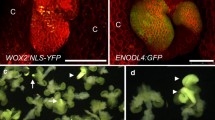Abstract
Apricot (Prunus armeniaca L.) embryos at three stages of development were cultured on C2d, SBH and WPM media. In vitro culture produced high percentages of germination and seedlings throughout all three developmental stages. Significant media effects were noted for changes in both embryo length and weight during the culture period, as well as number of plants produced. Embryos between 5 and 9 mm (developmental stage I) germinated and developed into plants in a significantly higher percentage than in the other two more mature stages. Therefore, embryo culture can be successfully used as a tool in an apricot breeding program to obtain higher percentages of seedlings from planned hybridization or to overcome a lack of seed germination.
Similar content being viewed by others
References
Al-Abta S & Collin HA (1979) Endogenous auxin and cytokinin changes during embryoid development in celery tissue cultures. New Phytol. 82: 29–35
Ammirato PV (1986) Control and expression of morphogenesis in culture. In: Withers LA & Alderson PG (Eds) Plant Tissue Culture and its Agricultural Applications (pp 23–45). Butterworths, London
Bailey CH & Hough LF (1975) Apricots. In: Janick J & Moore JN (Eds) Advances in Fruit Breeding (pp 367–383). Purdue University Press, West Lafayette, Indiana
Chao L & Walker DR (1966) Effects of temperature, chemicals and seed coat on apricot and peach seed germination and growth. J. Amer. Soc. Hort. Sci. 88: 232–238
Chee R & Pool RM (1987) Improved inorganic media constituents for in vitro shoot multiplication of Vitis. Scientia Hort. 32: 85–95
Crossa-Raynaud PH (1966) Techniques of hybridizations and of embryo culture with apricot. Doc. Tech. Inst. Natl. Rech. Agron. Tunisie 22: 1–18
Davison RM, Rudnicki RM & Bukovac MJ (1976) Endogenous plant growth substances in developing fruit of Prunus cerasus L.V. Changes in inhibitor (ABA) levels in the seed and pericarp. J. Amer. Soc. Hort. Sci. 101: 519–523
Leopold AC & Kriedemann PE (1975) Plant Growth and Development. McGraw-Hill Book Company, New York
Lloyd G & McCown B (1981) Commercially feasible micropropagation of mountain laurel, Kalmia latifolia, by use of shoot-tip culture. Comb. Proc. Intl. Plant Prop. Soc. 30: 421–427
Mehanna HT, Martin GC & Nishijima C (1985) Effects of temperature, chemical treatments and endogenous hormone content on peach seed germination and subsequent seedling growth. Scientia Hort. 27: 63–73
Mehlenbacher SA, Cociu V & Hough LF (1990) Apricots (Prunus). In: Moore JN & Ballington JR (Eds) Genetic Resources of Temperate Fruit and Nut Crops (pp 63–107). Intl. Soc. Hort. Sci. Wageningen
Rajasekaran K, Vine J & Mullins MG (1982) Dormancy in somatic embryos and seeds of Vitis: changes in endogenous abscisic acid during embryogeny and germination. Planta 154: 139–144
Ramming DW (1976) Crossability, morphological characteristics and frequency of chiasmata of diploid plums, apricots and their hybrids. Ph.D. Thesis, Rutgers University, New Jersey
Ramming DW (1983) Embryo culture. In: Moore JN & Janick J (Eds) Methods in Fruit Breeding (pp 136–144). Purdue University Press, West Lafayette, Indiana
Ramming DW (1986) Embryo rescue techniques in nectarine and peach breeding. N.Z. Agronomy Society. Special Publication n.5: 371–374
Ramming DW (1990) The use of embryo culture in fruit breeding. HortScience 25: 393–398
Smith CA, Bailey CH & Hough LF (1969) Methods for germinating seeds of some fruit species with special reference to growing seedlings from immature embryos. N.J. Agr. Expt. Sta. Bul. 823
Stewart JM (1981) In vitro fertilization and embryo rescue. Environ. Exp. Bot. 21: 301–305
Tukey HB (1933) Artificial culture of sweet cherry embryos. J. Hered. 24: 7–12
Walton DC (1990) Biochemistry and physiology of abscisic acid. Annu. Rev. Plant Physiol. 31: 453–489
Zagaja SW (1962) After-ripening requirements of immature fruit tree embryos. Hort. Res. 2: 19–34
Zdruikovskaya-Rikhter AI (1986) Production of varieties of fruit plants in vitro by the method of isolated embryo culture. Dokl. Bot. Sci. 283/285: 74–76
Zielinski QB (1977) Modern Systematic Pomology. Pomona Books, Ontario
Author information
Authors and Affiliations
Rights and permissions
About this article
Cite this article
Burgos, L., Ledbetter, C.A. Improved efficiency in apricot breeding: Effects of embryo development and nutrient media on in vitro germination and seedling establishment. Plant Cell Tiss Organ Cult 35, 217–222 (1993). https://doi.org/10.1007/BF00037273
Received:
Accepted:
Issue Date:
DOI: https://doi.org/10.1007/BF00037273




